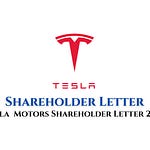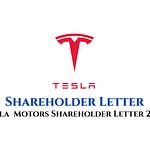Tesla Q1 2018 - Q4 2018 Financial and Operational Briefing
Sources: Tesla Motors – First Quarter 2018 Shareholder Letter
Tesla Motors, Inc. – Second Quarter 2018 Shareholder Letter
Tesla Motors, Inc.– Third Quarter 2018 Shareholder Letter
Tesla Motors, Inc.– Fourth Quarter & Full Year 2018 Shareholder Letter
Executive Summary
Tesla experienced a pivotal year in 2018, primarily driven by the ramp-up of Model 3 production. The company transitioned from a period of significant losses to achieving GAAP net income and positive free cash flow in Q3 and Q4 2018. The Model 3 quickly gained dominant market share in its segment in the US, demonstrating strong demand that extends beyond premium sedan owners. Tesla also made strides in its energy storage business and expanded its global infrastructure for charging and service.
Key Themes and Most Important Ideas/Facts:
1. Model 3 Production Ramp and Market Penetration
Significant Production Increase: Model 3 production saw a dramatic increase throughout 2018.
Q1 2018: Production hit 2,270 units/week by April, exceeding 2,000 for three straight weeks.
Q2 2018: Tesla achieved a weekly production of approximately 5,000 Model 3 cars multiple times by July, along with 2,000 Model S and X. The target was to reach 6,000 Model 3s per week by late August and 10,000 per week sometime in 2019.
Q3 2018: Average weekly Model 3 production (excluding planned shutdowns) was roughly 4,300 units per week.
Q4 2018 Outlook: Tesla aimed to sustain 7,000 units per week by the end of 2019 and a goal of 10,000 vehicles per week on a sustained basis including Gigafactory Shanghai. Total 2019 deliveries are projected to be 360,000 to 400,000 vehicles, a 45% to 65% growth over 2018.
Market Dominance: The Model 3 rapidly became a market leader in the mid-sized premium sedan segment in the US.
By April 2018 (Q1), Model 3 was "on the cusp of becoming the best-selling mid-sized premium sedan in the US."
In July 2018 (Q2), Model 3 achieved the "#1 market share position in its segment in the US" and "outsold all other mid-sized premium sedans combined, accounting for 52% of the segment overall." (Source: Q2 2018 Update)
In Q3 2018, Model 3 was the "best-selling car in the US in terms of revenue and the 5th best-selling car in terms of volume." (Source: Q3 2018 Update)
Broad Market Appeal: Trade-in data indicated that Model 3's appeal extends significantly beyond its direct competitors.
In Q2 2018, Tesla noted, "the total addressable market for Model 3 is much larger than mid-sized premium sedans. We are drawing customers from many other segments, including non-premiums sedans and hatchbacks."
Q4 2018 data revealed that "only 17% [of Model 3 trade-ins] are other mid-sized premium sedans" and "almost 60% of these trade-ins are non-premium vehicles." Many buyers were also "trading down in size from a larger car or a SUV to a Model 3." (Source: Q4 2018 Update)
Performance and Design: The Model 3 Performance variant, launched in Q2 2018, received high praise for its acceleration (0-60 mph in 3.5 seconds), placing it in "supercar territory." Its energy efficiency significantly improved to 4.1 EPA miles per kWh, "the highest efficiency for any all-wheel drive EV." (Source: Q3 2018 Update)
2. Financial Performance and Profitability
Shift to Profitability: After consistent losses, Tesla achieved GAAP net income and positive free cash flow in the latter half of 2018.
Q1 2018 Outlook: Expecting "positive GAAP net income and positive cash flow in Q3 and Q4 2018."
Q2 2018: Model 3 gross margin turned "slightly positive in Q2." The company had "$2.2B of cash and cash equivalents at Q2-end, expected to grow in Q3 and Q4."
Q3 2018: A historic quarter with "GAAP net income of $312 million" and "free cash flow (operating cash flow less capex) of $881 million." Model 3 GAAP gross margin exceeded 20%. Cash and cash equivalents increased by $731 million to $3.0B.
Q4 2018: Achieved GAAP net income of $139.483 million and continued positive free cash flow. Cash and cash equivalents increased to $3.685 billion.
Gross Margin Improvement:Automotive gross margin increased to 20.6% GAAP and 21.0% non-GAAP in Q2 2018.
Model 3 gross margin was expected to reach "approximately 15% in Q3 and to approximately 20% in Q4." (Source: Q2 2018 Update)
In Q3 2018, Model 3 gross margin was "greater than 20%," and overall Automotive GAAP gross margin improved to 25.8%.
Q4 2018 Automotive GAAP gross margin was 24.3%. Tesla targeted a "25% Model 3 non-GAAP gross margin at some point in 2019."
Cost Management:"Major cost restructuring executed in Q2" 2018.
Capex projection for 2018 adjusted to <$2.5B (from >$3.4B in Q1).
Model S and X production efficiencies improved 15% in 2018.
Tesla emphasized increasing capacity through "improving utilization of our existing lines and making selective improvements to address bottlenecks rather than creating entirely new duplicated lines" as the "most capital efficient approach." (Source: Q2 2018 Update)
Restructuring actions in Q1 2019 were expected to reduce costs by approximately $400 million annually.
3. Global Expansion and Infrastructure
Gigafactory Shanghai (Gigafactory 3): Announced in Q2 2018, with construction starting in January 2019 (Q4 2018 update).
Expected initial capacity of "roughly 250,000 vehicles and battery packs per year," growing to 500,000.
First cars expected off the line in "about three years" (from Q2 2018), with initial stamping, paint, body joining, and general assembly by end of 2019.
Aimed to provide "truly affordable version of Model 3" to Chinese customers by localizing manufacturing, addressing high import duties.
Much of the investment for Gigafactory 3 is expected to be funded through local debt.
Battery Production: Gigafactory 1 battery production reached an "annualized run rate of roughly 20 GWh" by the end of July 2018, making it the "highest-volume battery plant in the world." (Source: Q2 2018 Update) Tesla stated it "currently produces more batteries in terms of kWh than all other carmakers combined."
Service and Charging Network Expansion:Opened 8 new store/service locations in Q2 2018 (347 total).
Mobile Service fleet grew to over 340 vehicles by Q2 2018, preferred by customers for at-home/work repairs.
103 new Supercharger locations opened in Q2 2018, totaling 1,308 stations and over 10,800 Superchargers globally. Celebrated 10,000th Supercharger stall in June 2018.
4. Energy Products Business
Significant Growth: Despite focus on Model 3, the energy business grew significantly.
Energy storage deployments grew 106% YoY in Q2 2018 to 203 MWh.
During the first half of 2018, energy storage deployments were 450% higher compared to the same period last year.
Reached 1 GWh of energy storage deployed worldwide by May 2018, aiming for another GWh in the next 9-12 months.
Hornsdale Powerpack project in South Australia led to a "90% decline in grid maintenance cost." (Source: Q2 2018 Update)
Q3 2018 energy generation and storage revenue increased by 7% QoQ and 26% YoY, with gross margin improving to 17.2%.
Solar Deployments: Deployed 84 MW of solar in Q2 2018 (11% increase over Q1). Cash and loan sales made up 68% of residential deployments, up from 37% in Q2 2017, contributing to improved cash generation and profitability in Q4 2018. Solar Roof production was expected to accelerate significantly in H2 2018 and ramp up in 2019.
5. Other Key Developments
Model S and X Performance: Demand remained high, with Q2 2018 being the highest Q2 for orders ever. Deliveries for Model S and X were expected to accelerate in H2 2018, targeting 100,000 deliveries for the year (achieved 99,475 in 2018). Simplified options and improved production efficiencies led to 15% efficiency gains in 2018.
Federal Tax Credit Impact: Delivery of the 200,000th vehicle in the US in July 2018 meant full $7,500 federal tax credit was available until end of 2018, then phasing out in 2019. This was expected to cause a pull-forward of demand for Model S and X into 2018, leading to a projected slight decline in Q1 2019 deliveries for these models.
Direct Order and Test Drives: Tesla moved to a direct order system for Model 3 in US and Canada, stopping reservations. "Demand will accelerate even further once we offer leases, less expensive variants, and orders outside of North America." (Source: Q2 2018 Update) Test drive requests for Model 3 were high, with conversion rates higher than for Model S.
Software and Safety: Implemented significant Autopilot updates and mapping architecture improvements in Q1 2018. Model 3 received a 5-star NHTSA safety rating in every category and sub-category in Q3 2018.
China Tariffs: Increased tariffs on US vehicle imports to China (to 40%) led to price adjustments and expected negative impact on short-term China volumes, but global deliveries could be partially diverted.
Inventory Management: US vehicle inventory at the end of Q3 2018 was the lowest in the industry when measured in days of sales, and the lowest in over two years for Tesla.
Model Y & Tesla Semi: Planned for tooling and development in 2019, with Model Y benefiting from sharing about 75% of components with Model 3 for faster ramp and lower production line cost.
Conclusion
2018 marked a significant turning point for Tesla, successfully navigating the Model 3 production ramp and achieving sustained profitability and positive cash flow in the latter half of the year. The company demonstrated the strong market appeal of its electric vehicles, particularly the Model 3, which is expanding beyond traditional premium segments. Strategic global expansion, notably with Gigafactory Shanghai, and continued advancements in battery and energy storage technologies position Tesla for continued growth in the electric vehicle and sustainable energy markets.













Share this post